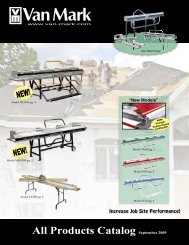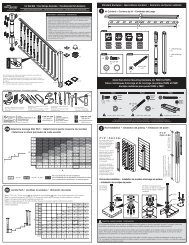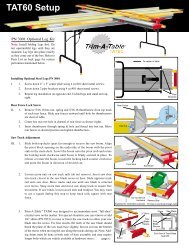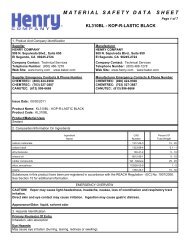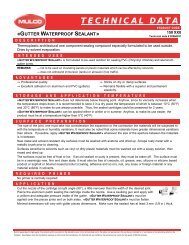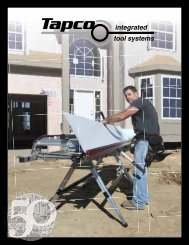Material Safety Data Sheet - Buchner Manufacturing
Material Safety Data Sheet - Buchner Manufacturing
Material Safety Data Sheet - Buchner Manufacturing
You also want an ePaper? Increase the reach of your titles
YUMPU automatically turns print PDFs into web optimized ePapers that Google loves.
1 .<br />
Product name<br />
Synonym<br />
Trade name<br />
<strong>Material</strong> uses<br />
Manufacturer<br />
Product and company identification<br />
Validation date<br />
Print date<br />
Responsible name<br />
In case of emergency<br />
Product use<br />
2 .<br />
Emergency overview<br />
:<br />
:<br />
:<br />
:<br />
:<br />
:<br />
:<br />
:<br />
:<br />
<strong>Material</strong> <strong>Safety</strong> <strong>Data</strong> <strong>Sheet</strong><br />
SUPRA ACADIA 104810<br />
Not available.<br />
Not available.<br />
Not available.<br />
Akzo Nobel Canada Inc.<br />
2505 De la Métropole,<br />
Longueuil, QC, J4G 1E5<br />
2012-10-31.<br />
2012-10-31.<br />
Regulatory Department<br />
450-442-7923<br />
8:00 - 17:00<br />
: Solvent based sealer<br />
Hazards identification<br />
:<br />
WARNING!<br />
SUPRA ACADIA 104810<br />
Medical conditions<br />
aggravated by overexposure<br />
See toxicological information (section 11)<br />
3 .<br />
:<br />
FLAMMABLE LIQUIDS HARMFUL IF SWALLOWED. CAUSES RESPIRATORY<br />
TRACT, EYE AND SKIN IRRITATION. MAY BE HARMFUL IF ABSORBED THROUGH<br />
SKIN. CONTAINS MATERIAL THAT MAY CAUSE TARGET ORGAN DAMAGE,<br />
BASED ON ANIMAL DATA. POSSIBLE CANCER HAZARD - CONTAINS MATERIAL<br />
WHICH MAY CAUSE CANCER, BASED ON ANIMAL DATA.<br />
Flammable liquid. Harmful if swallowed. May be harmful if absorbed through skin.<br />
Irritating to eyes, respiratory system and skin. Keep away from heat, sparks and flame.<br />
Avoid exposure - obtain special instructions before use. Do not breathe vapor or mist.<br />
Do not ingest. Do not get in eyes. Avoid contact with skin and clothing. Contains<br />
material that may cause target organ damage, based on animal data. Contains material<br />
which may cause cancer, based on animal data. Risk of cancer depends on duration<br />
and level of exposure. Use only with adequate ventilation. Keep container tightly closed<br />
and sealed until ready for use. Wash thoroughly after handling.<br />
Pre-existing disorders involving any target organs mentioned in this MSDS as being at<br />
risk may be aggravated by over-exposure to this product.<br />
Composition/information on ingredients<br />
Name CAS number %<br />
xylene ( mix of isomers o,m,p, and ethyl benzene ) 1330-20-7 30 - 60<br />
titanium dioxide 13463-67-7 1 - 5<br />
sodium potassium aluminum silicate 37244-96-5 1 - 5<br />
There are no additional ingredients present which, within the current knowledge of the supplier and in the<br />
concentrations applicable, are classified as hazardous to health or the environment and hence require reporting in<br />
this section.<br />
2012-10-31.<br />
1/10
SUPRA ACADIA 104810<br />
4 .<br />
First aid measures<br />
Eye contact<br />
Skin contact<br />
Inhalation<br />
Ingestion<br />
Protection of first-aiders<br />
Notes to physician<br />
5 .<br />
Fire-fighting measures<br />
Flammability of the product :<br />
Extinguishing media<br />
Suitable :<br />
Not suitable :<br />
Special exposure hazards :<br />
Hazardous combustion<br />
products<br />
Special protective<br />
equipment for fire-fighters<br />
Special remarks on fire<br />
hazards<br />
Special remarks on<br />
explosion hazards<br />
6 .<br />
Environmental precautions<br />
:<br />
:<br />
:<br />
:<br />
:<br />
Check for and remove any contact lenses. Immediately flush eyes with plenty of water<br />
for at least 15 minutes, occasionally lifting the upper and lower eyelids. Get medical<br />
attention immediately.<br />
In case of contact, immediately flush skin with plenty of water for at least 15 minutes<br />
while removing contaminated clothing and shoes. Wash clothing before reuse. Clean<br />
shoes thoroughly before reuse. Get medical attention immediately.<br />
Move exposed person to fresh air. If not breathing, if breathing is irregular or if<br />
respiratory arrest occurs, provide artificial respiration or oxygen by trained personnel.<br />
Loosen tight clothing such as a collar, tie, belt or waistband. Get medical attention<br />
immediately.<br />
Wash out mouth with water. Do not induce vomiting unless directed to do so by medical<br />
personnel. Never give anything by mouth to an unconscious person. Get medical<br />
attention immediately.<br />
: No action shall be taken involving any personal risk or without suitable training. If it is<br />
suspected that fumes are still present, the rescuer should wear an appropriate mask or<br />
self-contained breathing apparatus. It may be dangerous to the person providing aid to<br />
give mouth-to-mouth resuscitation. Wash contaminated clothing thoroughly with water<br />
before removing it, or wear gloves.<br />
:<br />
:<br />
:<br />
No specific treatment. Treat symptomatically. Contact poison treatment specialist<br />
immediately if large quantities have been ingested or inhaled.<br />
Flammable liquid. In a fire or if heated, a pressure increase will occur and the container<br />
may burst, with the risk of a subsequent explosion. The vapor/gas is heavier than air<br />
and will spread along the ground. Vapors may accumulate in low or confined areas or<br />
travel a considerable distance to a source of ignition and flash back. Runoff to sewer<br />
may create fire or explosion hazard.<br />
Use dry chemical, CO2, water spray (fog) or foam.<br />
Do not use water jet.<br />
Promptly isolate the scene by removing all persons from the vicinity of the incident if<br />
there is a fire. No action shall be taken involving any personal risk or without suitable<br />
training. Move containers from fire area if this can be done without risk. Use water<br />
spray to keep fire-exposed containers cool.<br />
: Decomposition products may include the following materials:<br />
carbon dioxide<br />
carbon monoxide<br />
metal oxide/oxides<br />
Fire-fighters should wear appropriate protective equipment and self-contained breathing<br />
apparatus (SCBA) with a full face-piece operated in positive pressure mode.<br />
Not available.<br />
Not available.<br />
Accidental release measures<br />
Personal precautions :<br />
Methods for cleaning up<br />
No action shall be taken involving any personal risk or without suitable training.<br />
Evacuate surrounding areas. Keep unnecessary and unprotected personnel from<br />
entering. Do not touch or walk through spilled material. Shut off all ignition sources. No<br />
flares, smoking or flames in hazard area. Do not breathe vapor or mist. Provide<br />
adequate ventilation. Wear appropriate respirator when ventilation is inadequate. Put<br />
on appropriate personal protective equipment (see section 8).<br />
: Avoid dispersal of spilled material and runoff and contact with soil, waterways, drains<br />
and sewers. Inform the relevant authorities if the product has caused environmental<br />
pollution (sewers, waterways, soil or air).<br />
2012-10-31.<br />
2/10
SUPRA ACADIA 104810<br />
6 .<br />
Accidental release measures<br />
Small spill :<br />
Large spill :<br />
7 .<br />
Handling<br />
Handling and storage<br />
:<br />
Stop leak if without risk. Move containers from spill area. Dilute with water and mop up<br />
if water-soluble or absorb with an inert dry material and place in an appropriate waste<br />
disposal container. Use spark-proof tools and explosion-proof equipment. Dispose of<br />
via a licensed waste disposal contractor.<br />
Stop leak if without risk. Move containers from spill area. Approach release from<br />
upwind. Prevent entry into sewers, water courses, basements or confined areas. Wash<br />
spillages into an effluent treatment plant or proceed as follows. Contain and collect<br />
spillage with non-combustible, absorbent material e.g. sand, earth, vermiculite or<br />
diatomaceous earth and place in container for disposal according to local regulations<br />
(see section 13). Use spark-proof tools and explosion-proof equipment. Dispose of via<br />
a licensed waste disposal contractor. Contaminated absorbent material may pose the<br />
same hazard as the spilled product. Note: see section 1 for emergency contact<br />
information and section 13 for waste disposal.<br />
Put on appropriate personal protective equipment (see section 8). Eating, drinking and<br />
smoking should be prohibited in areas where this material is handled, stored and<br />
processed. Workers should wash hands and face before eating, drinking and smoking.<br />
Do not get in eyes or on skin or clothing. Do not breathe vapor or mist. Do not ingest.<br />
Use only with adequate ventilation. Wear appropriate respirator when ventilation is<br />
inadequate. Do not enter storage areas and confined spaces unless adequately<br />
ventilated. Keep in the original container or an approved alternative made from a<br />
compatible material, kept tightly closed when not in use. Store and use away from heat,<br />
sparks, open flame or any other ignition source. Use explosion-proof electrical<br />
(ventilating, lighting and material handling) equipment. Use non-sparking tools. Take<br />
precautionary measures against electrostatic discharges. To avoid fire or explosion,<br />
dissipate static electricity during transfer by grounding and bonding containers and<br />
equipment before transferring material. Empty containers retain product residue and<br />
can be hazardous. Do not reuse container.<br />
Storage<br />
:<br />
Store in accordance with local regulations. Store in a segregated and approved area.<br />
Store in original container protected from direct sunlight in a dry, cool and well-ventilated<br />
area, away from incompatible materials (see section 10) and food and drink. Eliminate<br />
all ignition sources. Separate from oxidizing materials. Keep container tightly closed<br />
and sealed until ready for use. Containers that have been opened must be carefully<br />
resealed and kept upright to prevent leakage. Do not store in unlabeled containers. Use<br />
appropriate containment to avoid environmental contamination.<br />
8 .<br />
Exposure controls/personal protection<br />
Product name<br />
xylene ( mix of isomers o,m,p, and ethyl benzene<br />
)<br />
Exposure limits<br />
ACGIH TLV (United States, 1/2009). Notes: 1996 Adoption<br />
Substances for which there is a Biological Exposure Index or<br />
Indices Refers to Appendix A -- Carcinogens.<br />
STEL: 651 mg/m³ 15 minute(s).<br />
STEL: 150 ppm 15 minute(s).<br />
TWA: 434 mg/m³ 8 hour(s).<br />
TWA: 100 ppm 8 hour(s).<br />
2012-10-31.<br />
OSHA PEL (United States, 11/2006).<br />
TWA: 435 mg/m³ 8 hour(s).<br />
TWA: 100 ppm 8 hour(s).<br />
OSHA PEL 1989 (United States, 3/1989).<br />
STEL: 655 mg/m³ 15 minute(s).<br />
STEL: 150 ppm 15 minute(s).<br />
TWA: 435 mg/m³ 8 hour(s).<br />
TWA: 100 ppm 8 hour(s).<br />
3/10
SUPRA ACADIA 104810<br />
8 .<br />
Exposure controls/personal protection<br />
titanium dioxide<br />
ACGIH TLV (United States, 1/2009). Notes: Substance identified by<br />
other sources as a suspected or confirmed human carcinogen.<br />
1996 Adoption Substances for which the TLV is higher than the<br />
OSHA Permissible Exposure Limit (PEL) and/or the NIOSH<br />
Recommended Exposure Limit (REL). See CFR 58(124) :36338-<br />
33351, June 30, 1993, for revised OSHA PEL. Refers to Appendix A -<br />
- Carcinogens.<br />
TWA: 10 mg/m³ 8 hour(s).<br />
Consult local authorities for acceptable exposure limits.<br />
Recommended monitoring<br />
procedures<br />
Engineering measures<br />
Hygiene measures<br />
Personal protection<br />
Respiratory<br />
Hands :<br />
Eyes<br />
Skin<br />
Environmental exposure<br />
controls<br />
:<br />
:<br />
:<br />
OSHA PEL (United States, 11/2006).<br />
TWA: 15 mg/m³ 8 hour(s). Form: Total dust<br />
OSHA PEL 1989 (United States, 3/1989).<br />
TWA: 10 mg/m³ 8 hour(s). Form: Total dust<br />
: If this product contains ingredients with exposure limits, personal, workplace atmosphere<br />
or biological monitoring may be required to determine the effectiveness of the ventilation<br />
or other control measures and/or the necessity to use respiratory protective equipment.<br />
: Use only with adequate ventilation. Use process enclosures, local exhaust ventilation or<br />
other engineering controls to keep worker exposure to airborne contaminants below any<br />
recommended or statutory limits. The engineering controls also need to keep gas, vapor<br />
or dust concentrations below any lower explosive limits. Use explosion-proof ventilation<br />
equipment.<br />
: Wash hands, forearms and face thoroughly after handling chemical products, before<br />
eating, smoking and using the lavatory and at the end of the working period. Appropriate<br />
techniques should be used to remove potentially contaminated clothing. Wash<br />
contaminated clothing before reusing. Ensure that eyewash stations and safety showers<br />
are close to the workstation location.<br />
Respirator selection must be based on known or anticipated exposure levels, the<br />
hazards of the product and the safe working limits of the selected respirator.<br />
Chemical-resistant, impervious gloves complying with an approved standard should be<br />
worn at all times when handling chemical products if a risk assessment indicates this is<br />
necessary.<br />
<strong>Safety</strong> eyewear complying with an approved standard should be used when a risk<br />
assessment indicates this is necessary to avoid exposure to liquid splashes, mists or<br />
dusts.<br />
Personal protective equipment for the body should be selected based on the task being<br />
performed and the risks involved and should be approved by a specialist before handling<br />
this product.<br />
: Emissions from ventilation or work process equipment should be checked to ensure they<br />
comply with the requirements of environmental protection legislation. In some cases,<br />
fume scrubbers, filters or engineering modifications to the process equipment will be<br />
necessary to reduce emissions to acceptable levels.<br />
Other protection<br />
Personal protective<br />
equipment (Pictograms)<br />
: Not available.<br />
:<br />
Not available.<br />
2012-10-31.<br />
4/10
SUPRA ACADIA 104810<br />
9 .<br />
Physical state<br />
Flash point<br />
Color<br />
Odor<br />
Physical and chemical properties<br />
pH<br />
Boiling/condensation point<br />
Melting/freezing point<br />
Specific gravity<br />
Vapor pressure<br />
Vapor density<br />
Volatility<br />
Odor threshold<br />
Evaporation rate<br />
VOC<br />
Dispersibility properties<br />
: Liquid.<br />
: Closed cup: 28°C (82.4°F)<br />
Auto-ignition temperature : 530°C (986°F)<br />
Flammable limits : Lower: 1.1%<br />
Upper: 7%<br />
Octanol/water partition<br />
coefficient<br />
Decomposition temperature<br />
Viscosity<br />
10 .<br />
Stability<br />
:<br />
:<br />
:<br />
:<br />
:<br />
:<br />
:<br />
:<br />
:<br />
:<br />
:<br />
:<br />
:<br />
Various<br />
Solvents<br />
Not applicable.<br />
139°C (282.2°F)<br />
-48°C (-54.4°F)<br />
0.98<br />
2.5 kPa (19 mm Hg)<br />
>1 [Air = 1]<br />
43.06% (v/v), 38.33% (w/w)<br />
Not available.<br />
0.6 (butyl acetate = 1)<br />
373.7 g/l [Method 24]<br />
Not dispersible in the following materials: cold water.<br />
: Not available.<br />
Stability and reactivity<br />
Hazardous polymerization<br />
Conditions to avoid<br />
<strong>Material</strong>s to avoid<br />
Hazardous decomposition<br />
products<br />
Conditions of reactivity :<br />
11 .<br />
: Not available.<br />
: Dynamic: 1025000 mPa·s (1025000 cP)<br />
:<br />
The product is stable.<br />
: Under normal conditions of storage and use, hazardous polymerization will not occur.<br />
: Avoid all possible sources of ignition (spark or flame). Do not pressurize, cut, weld,<br />
braze, solder, drill, grind or expose containers to heat or sources of ignition. Do not<br />
allow vapor to accumulate in low or confined areas.<br />
:<br />
:<br />
Reactive or incompatible with the following materials:<br />
oxidizing materials<br />
Under normal conditions of storage and use, hazardous decomposition products should<br />
not be produced.<br />
Flammable in the presence of the following materials or conditions: oxidizing materials.<br />
Slightly flammable in the presence of the following materials or conditions: open flames,<br />
sparks and static discharge.<br />
Not available.<br />
Toxicological information<br />
Acute toxicity<br />
Product/ingredient name Result Species Dose Exposure<br />
xylene ( mix of isomers o,m,p, and ethyl LD50 Dermal Rabbit >1700 mg/kg -<br />
benzene )<br />
LD50 Oral Rat 4300 mg/kg -<br />
LDLo Oral Human 50 mg/kg -<br />
LC50 Inhalation<br />
Gas.<br />
Rat 5000 ppm 4 hours<br />
Chronic toxicity<br />
Product/ingredient name Result Species Dose Exposure<br />
Not available.<br />
Irritation/Corrosion<br />
2012-10-31.<br />
5/10
SUPRA ACADIA 104810<br />
11 .<br />
Toxicological information<br />
Product/ingredient name Result Species Score Exposure Observation<br />
Not available.<br />
Sensitizer<br />
Product/ingredient name<br />
Not available.<br />
Carcinogenicity<br />
Product/ingredient name Result Species Dose Exposure<br />
Not available.<br />
Classification<br />
Product/ingredient name ACGIH IARC EPA NIOSH NTP OSHA<br />
xylene A4 3 - None. - -<br />
titanium dioxide A4 2B - - - -<br />
Mutagenicity<br />
Product/ingredient name Test Experiment Result<br />
Not available.<br />
Teratogenicity<br />
Product/ingredient name Result Species Dose Exposure<br />
Not available.<br />
Reproductive toxicity<br />
Product/ingredient name<br />
Not available.<br />
Synergistic products<br />
Potential acute health effects<br />
Inhalation<br />
Ingestion<br />
Skin<br />
Eyes<br />
Potential chronic health effects<br />
Chronic effects<br />
Carcinogenicity<br />
Mutagenicity<br />
Teratogenicity<br />
Developmental effects<br />
Fertility effects<br />
Target organs<br />
Over-exposure signs/symptoms<br />
Inhalation<br />
Ingestion<br />
Skin<br />
Maternal<br />
toxicity<br />
: Not available.<br />
:<br />
:<br />
:<br />
:<br />
Route of<br />
exposure<br />
Fertility<br />
Irritating to respiratory system.<br />
Toxic if swallowed.<br />
Species<br />
Development<br />
toxin<br />
Harmful in contact with skin. Irritating to skin.<br />
Irritating to eyes.<br />
Result<br />
Species Dose Exposure<br />
: Contains material that may cause target organ damage, based on animal data.<br />
: Contains material which may cause cancer, based on animal data. Risk of cancer<br />
depends on duration and level of exposure.<br />
: No known significant effects or critical hazards.<br />
: No known significant effects or critical hazards.<br />
: No known significant effects or critical hazards.<br />
: No known significant effects or critical hazards.<br />
: Contains material which may cause damage to the following organs: blood, kidneys,<br />
lungs, liver, gastrointestinal tract, upper respiratory tract, skin, eyes, central nervous<br />
system (CNS).<br />
: Adverse symptoms may include the following:<br />
respiratory tract irritation<br />
coughing<br />
: No specific data.<br />
: Adverse symptoms may include the following:<br />
irritation<br />
redness<br />
2012-10-31.<br />
6/10
SUPRA ACADIA 104810<br />
11 .<br />
Eyes<br />
12 .<br />
Toxicological information<br />
Ecological information<br />
Environmental effects<br />
Aquatic ecotoxicity<br />
: Adverse symptoms may include the following:<br />
pain or irritation<br />
watering<br />
redness<br />
: No known significant effects or critical hazards.<br />
Product/ingredient name Test Result<br />
Species<br />
xylene ( mix of isomers o,m,p, and ethyl<br />
benzene )<br />
- Acute LC50 8.5<br />
ppm Marine water<br />
Crustaceans -<br />
Daggerblade<br />
grass shrimp -<br />
Palaemonetes<br />
pugio - Adult<br />
- Acute LC50<br />
13500 to 16100<br />
ug/L Fresh water<br />
- Acute LC50<br />
13500 to 15034<br />
ug/L Fresh water<br />
- Acute LC50<br />
13500 to 19200<br />
ug/L Fresh water<br />
- Acute LC50<br />
13400 ug/L Fresh<br />
water<br />
- Acute LC50<br />
13300 to 16114<br />
ug/L Fresh water<br />
- Acute LC50<br />
12000 to 16114<br />
ug/L Fresh water<br />
- Acute LC50<br />
12000 to 13762<br />
ug/L Fresh water<br />
- Acute LC50 8600<br />
to 9591 ug/L<br />
Fresh water<br />
- Acute LC50 8500<br />
ug/L Marine water<br />
- Acute LC50 8200<br />
to 10032 ug/L<br />
Fresh water<br />
Fish - Bluegill -<br />
Lepomis<br />
macrochirus - 1.1<br />
g<br />
Fish - Bluegill -<br />
Lepomis<br />
macrochirus - 0.9<br />
g<br />
Fish - Rainbow<br />
trout,donaldson<br />
trout -<br />
Oncorhynchus<br />
mykiss - 0.9 g<br />
Fish - Fathead<br />
minnow -<br />
Pimephales<br />
promelas - 31<br />
days - 18.4 mm -<br />
0.077 g<br />
Fish - Bluegill -<br />
Lepomis<br />
macrochirus - 1.1<br />
g<br />
Fish - Bluegill -<br />
Lepomis<br />
macrochirus - 1.1<br />
g<br />
Fish - Bluegill -<br />
Lepomis<br />
macrochirus - 1.1<br />
g<br />
Fish - Bluegill -<br />
Lepomis<br />
macrochirus - 0.9<br />
g<br />
Crustaceans -<br />
Daggerblade<br />
grass shrimp -<br />
Palaemonetes<br />
pugio<br />
Fish - Rainbow<br />
trout,donaldson<br />
trout -<br />
Oncorhynchus<br />
mykiss - 0.6 g<br />
Exposure<br />
48 hours<br />
96 hours<br />
96 hours<br />
96 hours<br />
96 hours<br />
96 hours<br />
96 hours<br />
96 hours<br />
96 hours<br />
48 hours<br />
96 hours<br />
- Acute LC50 3300 Fish - Rainbow 96 hours<br />
2012-10-31.<br />
7/10
SUPRA ACADIA 104810<br />
12 .<br />
Ecological information<br />
Bioconcentration factor<br />
Mobility :<br />
Toxicity of the products of<br />
biodegradation<br />
: Not available.<br />
:<br />
Not available.<br />
Not available.<br />
to 4093 ug/L<br />
Fresh water<br />
- Acute LC50<br />
14400 ug/L Fresh<br />
water<br />
titanium dioxide - Acute EC50<br />
>1000000 ug/L<br />
Fresh water<br />
Conclusion/Summary<br />
Other adverse effects<br />
13 .<br />
Waste disposal<br />
Waste stream<br />
: Not available.<br />
Disposal considerations<br />
- Acute LC50 5.5<br />
ppm Fresh water<br />
- Acute LC50<br />
>1000000 ug/L<br />
Marine water<br />
- Chronic NOEC<br />
500 ppm Fresh<br />
water<br />
- Chronic NOEC 1<br />
ppm Fresh water<br />
: No known significant effects or critical hazards.<br />
:<br />
:<br />
trout,donaldson<br />
trout -<br />
Oncorhynchus<br />
mykiss - 0.6 g<br />
Fish - Bluegill -<br />
Lepomis<br />
macrochirus - 1.1<br />
g<br />
Daphnia - Water<br />
flea - Daphnia<br />
magna -
SUPRA ACADIA 104810<br />
14 .<br />
Transport information<br />
Regulatory<br />
information<br />
UN number<br />
Proper shipping<br />
name<br />
Classes PG* Label Additional<br />
information<br />
TDG Classification UN1133 ADHESIVES,<br />
containing flammable<br />
liquid<br />
3 III -<br />
IMDG Class<br />
UN1133<br />
ADHESIVES,<br />
containing flammable<br />
liquid<br />
3 III<br />
-<br />
IATA-DGR Class<br />
UN1133<br />
ADHESIVES,<br />
containing flammable<br />
liquid<br />
3<br />
III<br />
-<br />
Note: In accordance with the Canadian Transport of Dangerous Goods regulations by Road, we use the 1.17 exemption when<br />
applicable.<br />
PG* : Packing group<br />
15 .<br />
Regulatory information<br />
WHMIS (Canada)<br />
:<br />
Class B-2: Flammable liquid<br />
Class D-2A: <strong>Material</strong> causing other toxic effects (Very toxic).<br />
Class D-2B: <strong>Material</strong> causing other toxic effects (Toxic).<br />
This product has been classified in accordance with the hazard criteria of the Controlled Products Regulations<br />
and the MSDS contains all the information required by the Controlled Products Regulations.<br />
Label requirements :<br />
FLAMMABLE LIQUIDS HARMFUL IF SWALLOWED. CAUSES RESPIRATORY<br />
TRACT, EYE AND SKIN IRRITATION. MAY BE HARMFUL IF ABSORBED THROUGH<br />
SKIN. CONTAINS MATERIAL THAT MAY CAUSE TARGET ORGAN DAMAGE,<br />
BASED ON ANIMAL DATA. POSSIBLE CANCER HAZARD - CONTAINS MATERIAL<br />
WHICH MAY CAUSE CANCER, BASED ON ANIMAL DATA.<br />
Hazardous <strong>Material</strong><br />
Information System (U.S.A.)<br />
: Health<br />
* 2<br />
Flammability<br />
3<br />
Physical hazards<br />
0<br />
The customer is responsible for determining the PPE code for this material.<br />
Caution: HMIS® ratings are based on a 0-4 rating scale, with 0 representing minimal hazards or risks, and 4<br />
representing significant hazards or risks Although HMIS® ratings are not required on MSDSs under 29 CFR<br />
1910.1200, the preparer may choose to provide them. HMIS® ratings are to be used with a fully implemented<br />
HMIS® program. HMIS® is a registered mark of the National Paint & Coatings Association (NPCA). HMIS®<br />
materials may be purchased exclusively from J. J. Keller (800) 327-6868.<br />
16 .<br />
Other information<br />
Version : 13<br />
Notice to reader<br />
The manufacturer hereby declares that the information disclosed herein have been based on our raw material<br />
suppliers' data, information and notification. Such raw materials are being used as components in the<br />
manufacturing of the product. The manufacturer has no control over the nature and content of such information.<br />
The manufacturer fully reproduces all the information it holds on the constituent of the product, at the time it is<br />
manufactured. The manufacturer does not assume any liability whatsoever for the accuracy or completeness of<br />
the information contained herein. Final determination of suitability of any material is the sole responsibility of the<br />
user. By this data sheet, the manufacturer hereby discloses all the potential dangers it has knowledge of and<br />
which might be related to the using or manipulation of the product in order to allow the proper care to be brought<br />
2012-10-31.<br />
9/10
SUPRA ACADIA 104810<br />
16 .<br />
Other information<br />
and use with regard to the product. <strong>Material</strong>s used may present unknown hazards and should be used with<br />
caution. Although certain hazards are described herein, we cannot guarantee that these are the only hazards<br />
which exist and notification is hereby given to the user. The product must be handled with care and it is<br />
recommended to use all the required measures in order to ensure the protection and safety of any person using or<br />
handling the product. Notice is hereby given that injury can derive therefrom if the foregoing is not respected. The<br />
manufacturer assumes no responsibility for personal and/or material damage, lost or injury of whichever nature<br />
caused or which may occur following the wrongful, inappropriate, negligent or abusive use or handling of the<br />
product or from not having read the herein contained information.<br />
2012-10-31.<br />
10/10



